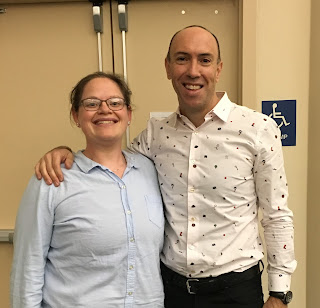 |
| https://drjohnrusin.com/about-us/ |
I spend a lot of time learning from Dr. John Rusin. John is a physical therapist and certified strength and conditioning coach who, from what I've been able to observe, does a thorough evaluation of his clients' movement patterns and then uses strength and conditioning principles which I've previously touched upon here to progress his clients to improved function, better strength, increased cardiovascular fitness, and overall improved quality of life and health. He's incredibly smart and provides me - and all of his followers - with boatloads of content that are generally organized in an interesting and user-friendly manner.
I'm not here writing a blog or developing a brand where I'm creating new ideas and new content (at least not yet). You won't see me videoing myself demonstrating exercises I've created any time soon. With regard to physical therapy, my blog is a write up of what I'm learning about from the experts and trying to synthesize their information so that I can use it with my patients. I've written about several other mentors and their impact on my practice, but today it's all about Dr. John Rusin and the top three things I've enjoyed learning from him.
First - John focuses his training around six key movement patterns: the squat, the hip hinge (deadlift), the lunge (single leg), the upper body push, upper body pull, and the carry. Prior to reading and watching John's work, I was already a fan of squats and deadlifts - though I haven't been under a bar in quite some time. I also focus heavily on single leg work in my own workouts and patient programs, though I wouldn't say I used lunges quite as much in the past as I have been more recently. I never used loaded carries before coming across John's work and I didn't do nearly enough pushing and pulling myself or with my patients who weren't rehabbing from an upper extremity injury. I've taken the time to read numerous postings from Dr. Rusin about his movement patterns and have found these patterns to be useful in my personal training as well as with the patients I work with.
Second - I know I had a Motor Control course and a Pediatrics course in PT school - but the carry over to application with actual patients somehow didn't really click. Dr. Rusin does a great job integrating these primitive progressions into his rehab programs as well as the educational materials he diseminates and I have been giving more and more attention to the sympathetic versus parasympathetic nervous system and energy systems (conditioning) because of him. Pay attention to the normal development of babies. First - they breathe. Second - they'll lift the head - the body follows the eyes, and the extremities move on a trunk that generally stays still because we need proximal mobility for distal stability and globally, the mobility and stability need to work in combination with one another.
The stability components are key. We physical therapists and rehab professionals are too often working on mobility and flexibility when a focus on stability would have greater outcomes, according to John's work. One area in which I strongly consider this is hamstring flexibility and toe touching. I often find that kids who can't bend and touch their toes don't really need passive hamstring stretching. They more frequently need strengthening and motor control of those hamstrings so that the muscle releases its protective hold and the person can function more optimally.
Finally - Dr. Rusin has recently been putting out video footage on his work helping to "Rebuild Dave Tate." This stuff is really cool. Dave Tate is a world class weight lifter and body builder who was dealing with numerous orthopedic injuries, surgeries, and deconditioning for which he reached out to Dr. Rusin. These guys got together and have been filming their interactions and posting segments walking you through John's subjective and objective evaluation components, the program he developed for Dave, and some follow up/progressions of the program. This site has links to the 9 current videos they've posted, and they're not done yet! This is an incredible resource for others and I have enjoyed watching (and re-watching) and also discussing the posts on John's Facebook with other followers that it felt essential to share this.
I haven't yet had the chance to meet Dr. Rusin in person yet since he operates out of Wisconsin, but he has numerous products available and I'm hoping to try some of his training options in the future when I finish my current plan. I'm so grateful there are clinicians out there that put out intelligent, immediately applicable information, all for free, all for the greater good.





